
A galaxy is a system of stars, stellar remnants, interstellar gas, dust, and dark matter bound together by gravity. The word is derived from the Greek galaxias (γαλαξίας), literally 'milky', a reference to the Milky Way galaxy that contains the Solar System. Galaxies, averaging an estimated 100 billion stars, range in size from dwarfs with less than a hundred million stars, to the largest galaxies known – supergiants with one hundred trillion stars, each orbiting its galaxy's center of mass. Most of the mass in a typical galaxy is in the form of dark matter, with only a few percent of that mass visible in the form of stars and nebulae. Supermassive black holes are a common feature at the centres of galaxies.

NGC 404 is a field galaxy located about 10 million light years away in the constellation Andromeda. It was discovered by William Herschel in 1784, and is visible through small telescopes. NGC 404 lies just beyond the Local Group and does not appear gravitationally bound to it. It is located within 7 arc-minutes of second magnitude star Mirach, making it a difficult target to observe or photograph and granting it the nickname "Mirach's Ghost".

NGC 5866 is a lenticular galaxy in the constellation Draco. NGC 5866 was most likely discovered by Pierre Méchain or Charles Messier in 1781, and independently found by William Herschel in 1788. Measured orbital velocities of its globular cluster system imply that dark matter makes up only 34±45% of the mass within 5 effective radii, a notable paucity.
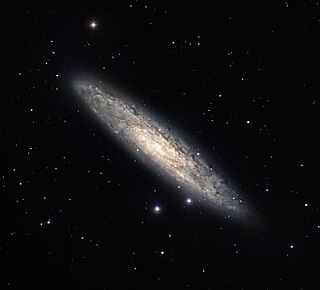
The Sculptor Galaxy is an intermediate spiral galaxy in the constellation Sculptor. The Sculptor Galaxy is a starburst galaxy, which means that it is currently undergoing a period of intense star formation.
A dark galaxy is a hypothesized galaxy with no stars. They received their name because they have no visible stars but may be detectable if they contain significant amounts of gas. Astronomers have long theorized the existence of dark galaxies, but there are no confirmed examples to date. Dark galaxies are distinct from intergalactic gas clouds caused by galactic tidal interactions, since these gas clouds do not contain dark matter, so they do not technically qualify as galaxies. Distinguishing between intergalactic gas clouds and galaxies is difficult; most candidate dark galaxies turn out to be tidal gas clouds. The best candidate dark galaxies to date include HI1225+01, AGC229385, and numerous gas clouds detected in studies of quasars.

The Canon EF 400mm are seven super-telephoto lenses made by Canon. These lenses have an EF mount that work with the EOS line of cameras. These lenses are widely used by sports and wildlife photographers.

NGC 474 is an elliptical galaxy about 100 million light years distant in the constellation Pisces. This large galaxy is known to possess tidal shells and tidal tails, although their origins remain unclear. One possible explanation is that NGC 474 interacted with a galaxy several billion years ago.

NGC 1052 is an elliptical galaxy in the constellation Cetus. It was discovered on January 10, 1785 by the astronomer William Herschel. It is a member of the eponymous NGC 1052 Group.
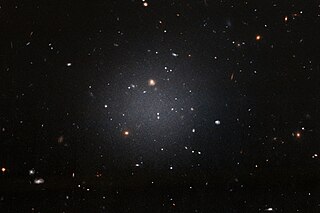
An ultra diffuse galaxy (UDG), or Dark galaxy, is an extremely low luminosity galaxy, the first example of which was discovered in the nearby Virgo Cluster by Allan Sandage and Bruno Binggeli in 1984. These galaxies have been studied for many years prior to their renaming in 2015. Their lack of luminosity is due to the lack of star-forming gas, which results in these galaxies being reservoirs of very old stellar populations.

Dragonfly 44 is an ultra diffuse galaxy in the Coma Cluster. This galaxy is well-known because observations of the velocity dispersion in 2016 suggested a mass of about one trillion solar masses, about the same as the Milky Way. This mass was consistent with a count of about 90 and 70 globular clusters observed around Dragonfly 44 in two different studies.

NGC 4494 is an elliptical galaxy located in the constellation Coma Berenices. It is located at a distance of circa 45 million light years from Earth, which, given its apparent dimensions, means that NGC 4494 is about 60,000 light years across. It was discovered by William Herschel in 1785.
The Dunlap Institute for Astronomy and Astrophysics at the University of Toronto is an astronomical research centre.

NGC 1052-DF2 is an ultra diffuse galaxy (UDG) in the constellation Cetus, which was identified in a wide-field imaging survey of the NGC 1052 group by the Dragonfly Telephoto Array. It has been proposed that the galaxy contains little or no dark matter, the first such discovery. On 20 March 2019, a follow-up study announcing the discovery of a second UDG lacking dark matter, NGC 1052-DF4, was published.

NGC 3311 is a super-giant elliptical galaxy located about 190 million light-years away in the constellation Hydra. The galaxy was discovered by astronomer John Herschel on March 30, 1835. NGC 3311 is the brightest member of the Hydra Cluster and forms a pair with NGC 3309 which along with NGC 3311, dominate the central region of the Hydra Cluster.
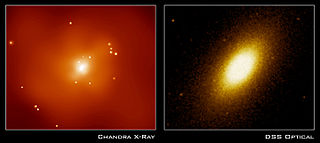
NGC 720 is an elliptical galaxy located in the constellation Cetus. It is located at a distance of circa 80 million light years from Earth, which, given its apparent dimensions, means that NGC 720 is about 110,000 light years across. It was discovered by William Herschel on October 3, 1785. The galaxy is included in the Herschel 400 Catalogue. It lies about three and a half degrees south and slightly east from zeta Ceti.

NGC 3585 is an elliptical or a lenticular galaxy located in the constellation Hydra. It is located at a distance of circa 60 million light-years from Earth, which, given its apparent dimensions, means that NGC 3585 is about 80,000 light years across. It was discovered by William Herschel on December 9, 1784.

NGC 5846 is an elliptical galaxy located in the constellation Virgo. It is located at a distance of circa 90 million light years from Earth, which, given its apparent dimensions, means that NGC 5846 is about 110,000 light years across. It was discovered by William Herschel on February 24, 1786. It lies near 110 Virginis and is part of the Herschel 400 Catalogue. It is a member of the NGC 5846 Group of galaxies, itself one of the Virgo III Groups strung out to the east of the Virgo Supercluster of galaxies.
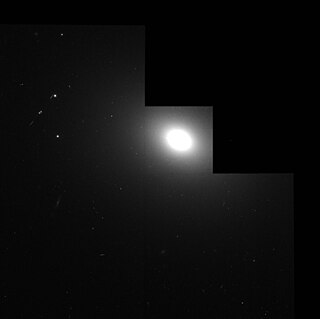
IC 1459 is an elliptical galaxy located in the constellation Grus. It is located at a distance of circa 85 million light-years from Earth, which, given its apparent dimensions, means that IC 1459 is about 130,000 light-years across. It was discovered by Edward Emerson Barnard in 1892.
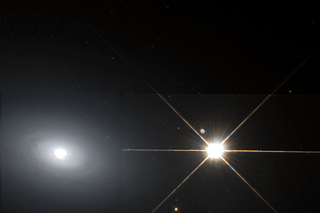
NGC 2974 is a lenticular galaxy located in the constellation Sextans. It is located at a distance of circa 90 million light years from Earth, which, given its apparent dimensions, means that NGC 2974 is about 90,000 light years across. It was discovered by William Herschel on January 6, 1785. NGC 2974 is located in the sky about 2 and a half degrees south-south east of Iota Hydrae and more than 6 degrees northeast of Alphard. A 10th magnitude star lies next to the galaxy, thus making it a challenging object at low magnifications. NGC 2974 is part of the Herschel 400 Catalogue.
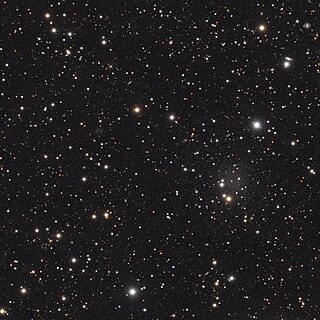
DGSAT I is a quenched, ultra diffuse galaxy (UDG) located on the outskirts of the Pisces-Perseus Supercluster, identified in 2016 during a visual inspection of a full color image of the Andromeda II dwarf galaxy. DGSAT I resides in a low-density environment compared to the densities where UDGs are typically found. Its chemical makeup have led astronomers to propose it was formed during the dawn of the universe when galaxies emerged in a different environment than today.

















